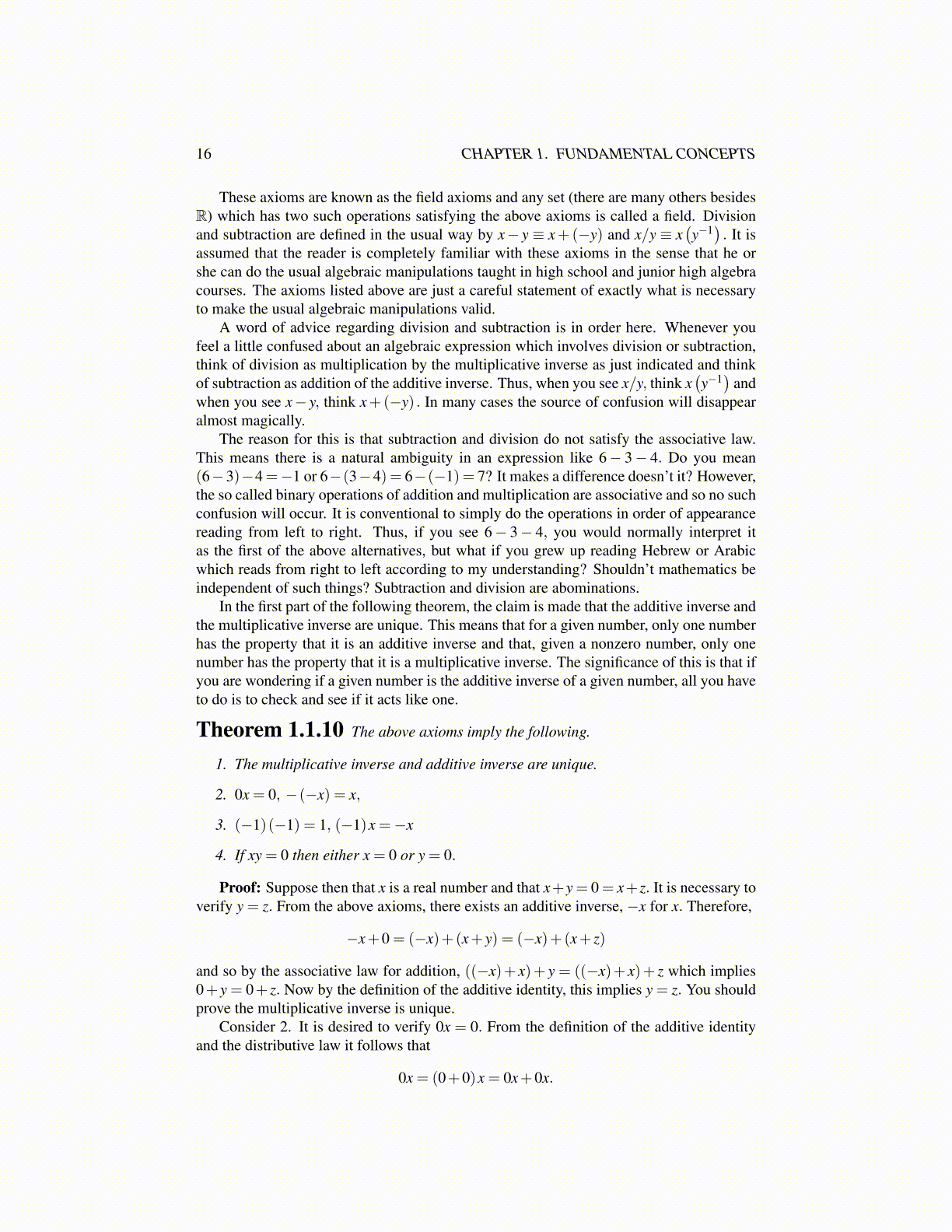
16 CHAPTER 1. FUNDAMENTAL CONCEPTS
These axioms are known as the field axioms and any set (there are many others besidesR) which has two such operations satisfying the above axioms is called a field. Divisionand subtraction are defined in the usual way by x− y ≡ x+(−y) and x/y ≡ x
(y−1). It is
assumed that the reader is completely familiar with these axioms in the sense that he orshe can do the usual algebraic manipulations taught in high school and junior high algebracourses. The axioms listed above are just a careful statement of exactly what is necessaryto make the usual algebraic manipulations valid.
A word of advice regarding division and subtraction is in order here. Whenever youfeel a little confused about an algebraic expression which involves division or subtraction,think of division as multiplication by the multiplicative inverse as just indicated and thinkof subtraction as addition of the additive inverse. Thus, when you see x/y, think x
(y−1)
andwhen you see x− y, think x+(−y) . In many cases the source of confusion will disappearalmost magically.
The reason for this is that subtraction and division do not satisfy the associative law.This means there is a natural ambiguity in an expression like 6 − 3 − 4. Do you mean(6−3)−4 =−1 or 6−(3−4) = 6−(−1) = 7? It makes a difference doesn’t it? However,the so called binary operations of addition and multiplication are associative and so no suchconfusion will occur. It is conventional to simply do the operations in order of appearancereading from left to right. Thus, if you see 6− 3− 4, you would normally interpret itas the first of the above alternatives, but what if you grew up reading Hebrew or Arabicwhich reads from right to left according to my understanding? Shouldn’t mathematics beindependent of such things? Subtraction and division are abominations.
In the first part of the following theorem, the claim is made that the additive inverse andthe multiplicative inverse are unique. This means that for a given number, only one numberhas the property that it is an additive inverse and that, given a nonzero number, only onenumber has the property that it is a multiplicative inverse. The significance of this is that ifyou are wondering if a given number is the additive inverse of a given number, all you haveto do is to check and see if it acts like one.
Theorem 1.1.10 The above axioms imply the following.
1. The multiplicative inverse and additive inverse are unique.
2. 0x = 0, −(−x) = x,
3. (−1)(−1) = 1, (−1)x =−x
4. If xy = 0 then either x = 0 or y = 0.
Proof: Suppose then that x is a real number and that x+y = 0 = x+z. It is necessary toverify y = z. From the above axioms, there exists an additive inverse, −x for x. Therefore,
−x+0 = (−x)+(x+ y) = (−x)+(x+ z)
and so by the associative law for addition, ((−x)+ x)+ y = ((−x)+ x)+ z which implies0+ y = 0+ z. Now by the definition of the additive identity, this implies y = z. You shouldprove the multiplicative inverse is unique.
Consider 2. It is desired to verify 0x = 0. From the definition of the additive identityand the distributive law it follows that
0x = (0+0)x = 0x+0x.